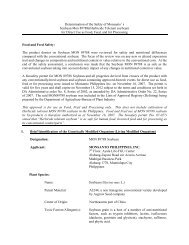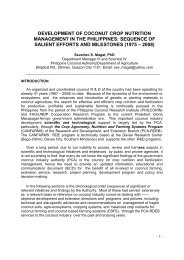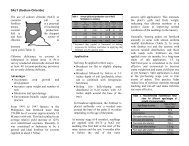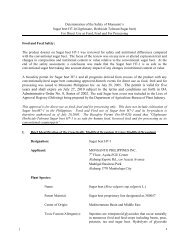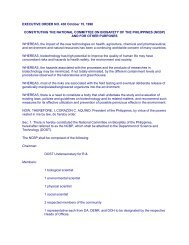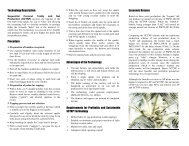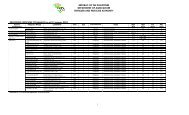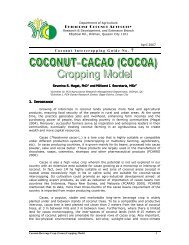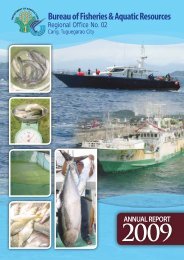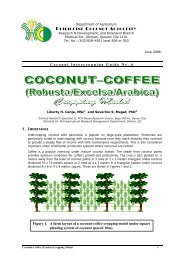Department of Agriculture - Philippine Coconut Authority ...
Department of Agriculture - Philippine Coconut Authority ...
Department of Agriculture - Philippine Coconut Authority ...
- No tags were found...
Create successful ePaper yourself
Turn your PDF publications into a flip-book with our unique Google optimized e-Paper software.
ahead <strong>of</strong> tugui by about one month. Tubers, especially those intended forsetts, are harvested at the later part <strong>of</strong> the period. Tubers intended forconsumption or for the market are sometimes harvested earlier, even beforefoliage yellowing sets in).A bolo or a similar handtool is used to dig around the tuber to loosen it fromthe soil. Then the tuber is lifted and clinging soil particles are removed. Thevine is cut at the base).For sandy soil, sturdy stick sharpened at one end is sometimes used to dig outthe tuber. For clay soil and for varieties with deeply buried tubers, an ubiharvester devised at PRCRTC may be used. The harvester is used like ashovel. Whatever tool is used to harvest the tubers, it is important that careshould be exercised so as not to injure them while digging).After tubers are cleaned, they are collected and placed in rattan baskets orbamboo or wooden crates lined with s<strong>of</strong>t materials such as banana leaves,paper or grass straw. Healthy and diseased tubers are placed in separatecontainers. The tubers are arranged in the container in two to four layers,depending upon tuber size, and a s<strong>of</strong>t material that can serve as cushion isplaced between layers and in the spaces between tubers in a layer. Thecontainer is then covered with paper or banana leaves and a string net iswoven over the mouth <strong>of</strong> the container if the tubers are to be transportedimmediately to the market. No cover is provided for the container if the tubersare to be transported to a nearby storage place. The tubers should betransported with minimum <strong>of</strong> jolting using a cart or a sled. (Root Crop Digest,PRIS Vol. 2 No. 4, 1987 ISSN 0116-4325 [http://vicarp.lsuvisca.edu.ph/technologies.htm).4.2.1.5 Ginger1) Land preparation – Plow and harrow twice or thrice to remove weeds, makefurrows 50 cm apart, 2.0 m away from the base <strong>of</strong> the coconuts).2) Varieties – Some <strong>of</strong> the varieties <strong>of</strong> ginger are: a)Native –small, fibrous andpungent rhizome; b) Imugan – improved native strain, medium –sizedrhizomes with prominent leaf scars, resistant to soil-borne diseases and yield30-70% more than native strain; c) Jamaica ‘oya” –pleasant aroma, pale,medium-sized rhizomes which turn brownish-yellow when dried; d) Hawaiian– extra large, yellowish brown with pinkish traces (PCA Intercropping Guide).3) Preparation <strong>of</strong> planting materials – Procure planting materials from reliablesources, use only fresh and healthy rhizomes. Cut rhizomes into seed pieces<strong>of</strong> about 20 grams each containing 2-3 bud-eyes. Wash seed pcs in tap waterand then soak in solution containing 45 grams Captan per 20 li <strong>of</strong> water for10-15 minutes. Plant seed pcs immediately).4) Maintenance –Fertilize with one (1) tbsp <strong>of</strong> complete fertilizer (1414-14) eightcm away from hills as side dressing. Gather coconut leaves, rice straws, driedbanana leaves, cogon straws and mulch the planted area. Apply 400 kg/ha <strong>of</strong>complete fertilizer on the 2 nd and 4 th months).5) Harvesting – can be done when stalks exhibit yellowing and withering, aboutnine (9) months after planting. Two methods <strong>of</strong> harvesting for:<strong>Coconut</strong>-Root Crops Cropping Model 16



